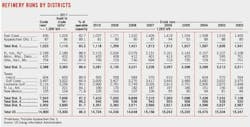US energy demand to stay weak in 2012 amid strong oil, gas production
View Article as Single page
Refining, pipelines
Capacity utilization at US refineries, which operated at an estimated 86.3% of capacity last year, will be little changed this year. Operable capacity will average 17.74 million b/d.
Cash operating margins in 2011 were up in the major refining centers other than the US East Coast, where tough market conditions have persisted for several years.
For the first 11 months of last year, the latest data available as OGJ went to press last week, the US East Coast cash operating margin averaged 37¢/bbl, down from a full-2010 average of $1.82/bbl, according to figures from Muse, Stancil & Co.
Meanwhile, the average 2011 operating margin through November was $21.44/bbl for US Midwest refiners compared with $8.15/bbl in 2010. The improvement in other regions was more muted: up 36% for US Gulf Coast refiners and up 20% for refiners on the US West Coast.
Citing deteriorating refining market conditions, refiner Sunoco Inc. reported last month that it would immediately idle "indefinitely" the main processing units at its 175,000-b/d Marcus Hook, Pa., refinery and continue to seek out a buyer as well as pursue options with third parties for alternate uses of the facility (OGJ Online, Dec. 12, 2011).
Earlier, ConocoPhillips announced its plan to sell its 185,000-b/cd refinery in Trainer, Pa., and associated pipelines and terminals.
Willie Chiang, ConocoPhillips senior vice-president of refining, attributed severe market pressure on US East Coast refining to product imports, weakness in motor fuel demand, and what he called "costly regulatory requirements" (OGJ Online, Sept. 27, 2011).
Also, ConocoPhillips said in November 2011 that it would divest its interest in Seaway Crude Pipeline Co. to Enbridge Holdings (Seaway) LLC, a subsidiary of Enbridge (US) Inc., which will reverse its flow to transport crude to the US Gulf Coast from the oversupplied hub in Cushing, Okla.
Enbridge Inc. and Enterprise Products Partners LP agreed to reverse the direction of oil flows on Seaway with an initial capacity of 150,000 b/d in second-quarter 2012. Following pump station additions and modifications, anticipated to be completed by early 2013, the capacity of the reversed Seaway Pipeline will reach 400,000 b/d (OGJ Online, Nov. 16, 2011).
The reversal of the Seaway pipeline will allow refiners to access supplies from Cushing. In addition, the reversal of Shell's Houma-to‐Houston pipeline by early 2013 will give Gulf Coast refiners easier access to the Eagle Ford crude.
The Shell Pipeline Co. LP project would reverse the existing service to connect the Houston and Port Arthur, Tex., markets with Louisiana markets. The reversal could enable the distribution of approximately 300,000 b/d of crude across the region depending upon the crudes types shipped, the company reported in August 2011.
Displaying 6/7
View Article as Single page


